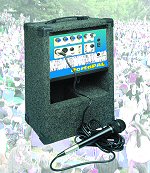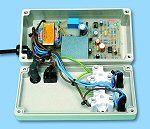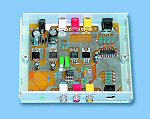The No. 1 UK Magazine for electronics technology and computer projects

![]() PORTAPAL Portable PA System (Part 1) — a state of the art 33W RMS design. This portable public address (PA) amplifier can be powered from the 240V a.c. mains or its inbuilt 12V d.c. sealed lead acid (SLA) supply. It delivers up to 70 watts and has a number of current-saving techniques that improves efficiency.
PORTAPAL Portable PA System (Part 1) — a state of the art 33W RMS design. This portable public address (PA) amplifier can be powered from the 240V a.c. mains or its inbuilt 12V d.c. sealed lead acid (SLA) supply. It delivers up to 70 watts and has a number of current-saving techniques that improves efficiency.
 Mixing for two 600 ohm balanced or unbalanced microphone inputs, guitar input and line imputs for a CD player or tape deck. Based around the Philips TDA1562Q. A considerable cost saving has been achieved by eliminating the need for large heavy mains transformers and smoothing capacitors on the power supply section. Part Two next month: full assembly details, all in full colour!
Mixing for two 600 ohm balanced or unbalanced microphone inputs, guitar input and line imputs for a CD player or tape deck. Based around the Philips TDA1562Q. A considerable cost saving has been achieved by eliminating the need for large heavy mains transformers and smoothing capacitors on the power supply section. Part Two next month: full assembly details, all in full colour!

![]() Power Up Intelligent Power Strip — an intelligent mains socket that turns on all your equipment at the flick of a switch. Switch on your PC and your peripherals will come on as well! Switch on your amplifier and your hifi gear will come on too. The same for your TV and home theatre system. An extremely useful design.
Power Up Intelligent Power Strip — an intelligent mains socket that turns on all your equipment at the flick of a switch. Switch on your PC and your peripherals will come on as well! Switch on your amplifier and your hifi gear will come on too. The same for your TV and home theatre system. An extremely useful design.
![]() MAINS VOLTAGE!
MAINS VOLTAGE!
Experienced constructors only. This project is not suitable for beginners.


![]() Video-Audio Booster for the Home Theatre — you can boost composite, S-video or component video plus audio signals with our booster circuit. It is based on a MAX497 quad video buffer i.c. that forms a wideband amplifier to boost TV theatre signals, especially when they sent over long cables. It handles stereo audio signals as well. Our top quality project article provides full constructional articles, in full colour detail so that you can build this project in complete confidence. Kits are available from Jaycar Electronics.
Video-Audio Booster for the Home Theatre — you can boost composite, S-video or component video plus audio signals with our booster circuit. It is based on a MAX497 quad video buffer i.c. that forms a wideband amplifier to boost TV theatre signals, especially when they sent over long cables. It handles stereo audio signals as well. Our top quality project article provides full constructional articles, in full colour detail so that you can build this project in complete confidence. Kits are available from Jaycar Electronics.
Vol. 35. No. 3
by Mike Kenward, Editor, Everyday Practical Electronics Magazine. Fred Bennett, the father of Practical Electronics and Everyday Electronics, has sadly died aged 85 after fighting cancer for many months. He leaves an invalid sister, Dorothy, whom he had looked after for most of his life, and a nephew, the son of his second sister who died some time ago. A quiet, private man, dedicated to his sister, Fred never married. He was widely read, an experienced amateur geologist and a member of the Dickens Society. Fred was involved in the launch of Practical Electronics in 1964 and later launched Everyday Electronics in 1971 (he had previously worked on Practical Wireless). He edited both magazines until Practical Electronics was relocated to Poole in Dorset in 1977 after which he continued the editorship of Everyday Electronics until he retired in 1986. It was Fred who decided the strategy of both PE and EE. In his quiet unassuming way he meticulously planned their development. I never knew him to be angry or to flap in a crisis; he was a gentleman of the old school and he had a way of getting things done without seeming to do anything. He was liked and respected by staff, contributors and readers alike. It was Fred that instigated the Teach-In series, the first being in the very first issue of EE in November 1971 - as readers will know, the bi-annual series is still running some 34 years and 17 series later. It has certainly stood the test of time and has been responsible for introducing many tens of thousands of readers to our hobby and to careers in electronics. Fred was responsible for setting the standard that made the magazines so successful, particularly through the seventies when the circulation of each magazine was well over 100,000 copies. He was responsible for offering me a job, for promoting me to assist with the launch of Everyday Electronics and teaching me how to help produce the first class magazines he had developed. I have much to thank him for, as no doubt have many who have been inspired by Fred's magazines - magazines which have survived for over 40 years. Our condolences to those he leaves behind. Rest in peace, Fred. Mike Kenward, Wimborne, Dorset, England. February 2006. |
